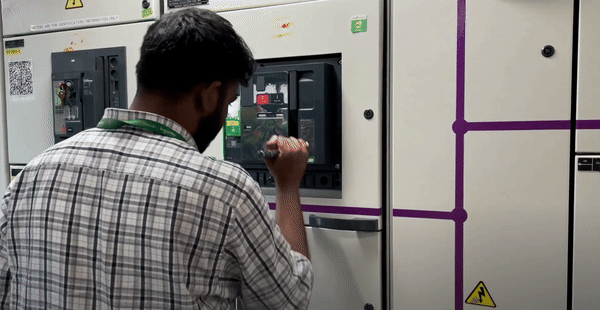TL;DR
Problem Statement
LOTO is critical for industrial safety — but it’s inconsistent, slow, and paper-bound. Operators rely on manual logs, SCADA teams lack visibility, and missed steps lead to costly delays and safety risks.
This project set out to digitise the LOTO process.
Worked as a Design engineer to build SE’s first certified digital LOTO solution, balancing regulatory constraints with on-ground usability. Collaborated with Ramakrishnan Kesavan & Ashok Kr. to align across engineering, compliance & deployment.
Primary users
Digital LOTO impacted multiple roles across the facility — each with different needs, responsibilities, and pain points -
Perform equipment lockouts and need clear, step-by-step task guidance to avoid errors.
Carry out servicing and rely on timely approvals and real-time status updates.
Ensure strict protocol compliance and need traceability across every action taken.
Monitor system state — require real-time visibility into lock status across the facility.
Oversee the broader safety ecosystem and need high-level insights into compliance.
Process
Step 1
LOTO Research & Industry References
Researched SCADA logs, paper-based permits, and IoT-based lock solutions to map gaps in current workflows.
Insights -
Existing tools were siloed and required workarounds.
Safety checks relied heavily on memory and handwritten notes.
No direct competitors, but adjacent systems (e.g. facility security) offered inspiration for scalable design.
Step 2
Compliance Validation & Technical Feasibility
We built an early working model using Schneider’s IoT tools and apps — simulating lockout triggers by reverse-engineering sensor behaviour. Engineers from the V&V lab supported us in rigging the prototype.
A QR-coded padlock stood in for an actual smart lock.
Demoed to safety experts to verify compliance with regulatory protocols.
Mapped all failure points in the manual process to show how our system would address them.
The digitised workflow passed safety review — no codes bypassed, no retraining needed.
Step 3
Testing Market Fit
To gauge strategic viability, we presented the prototype to senior leadership. The focus wasn’t just on feasibility — it was about future-proofing. Could this plug into the broader ecosystem? Would it scale?
Key feedback from the leadership team -
Don’t reinvent the lock — partner with IoT lock vendors who offer API access.
Skip the standalone app — integrate into an existing SE platform.
Clarify scope — narrow down the user group and environments where this would have most impact.
This input helped reshape the roadmap — from tech demo to scalable product direction.
Step 4
Refining the Specs
To narrow down the feature set, we turned to the users again — this time with structured prompts and a Kano survey. The goal? Understand what users actually valued and what just sounded cool on paper.
Here's what we learned -
Users preferred circuit-breaker-integrated locks over standalone ones — fewer moving parts, better compliance.
Prioritisation hinged on impact on satisfaction and safety alignment, not novelty.
The final spec list gave us a user-backed blueprint to move into full UI design.
Step 5
Wireframing & Prototyping
What’s locked, what’s not, what needs attention — all in one glance.
Step 6
Validation & Certification
Because this feature impacted critical safety workflows, it had to clear multiple compliance reviews across countries. That meant adapting it for local safety codes, workflows, and audit expectations.
I partnered with regional certification teams to fine-tune userflows, wireframes, and copy — ensuring the solution passed validation without losing its usability edge.
The result?
Simpler execution, better visibility, and a system that scales with safety at its core.
Simplified execution flow, cutting down process time by ~35%.
Gave SCADA and remote teams live visibility for safer, faster responses.
Brought transparency to audits with automated compliance checks.
Final wireframes and screens have been redacted due to NDA restrictions. If you’d like to learn more about the process, outcomes, or my role—feel free to reach out.









